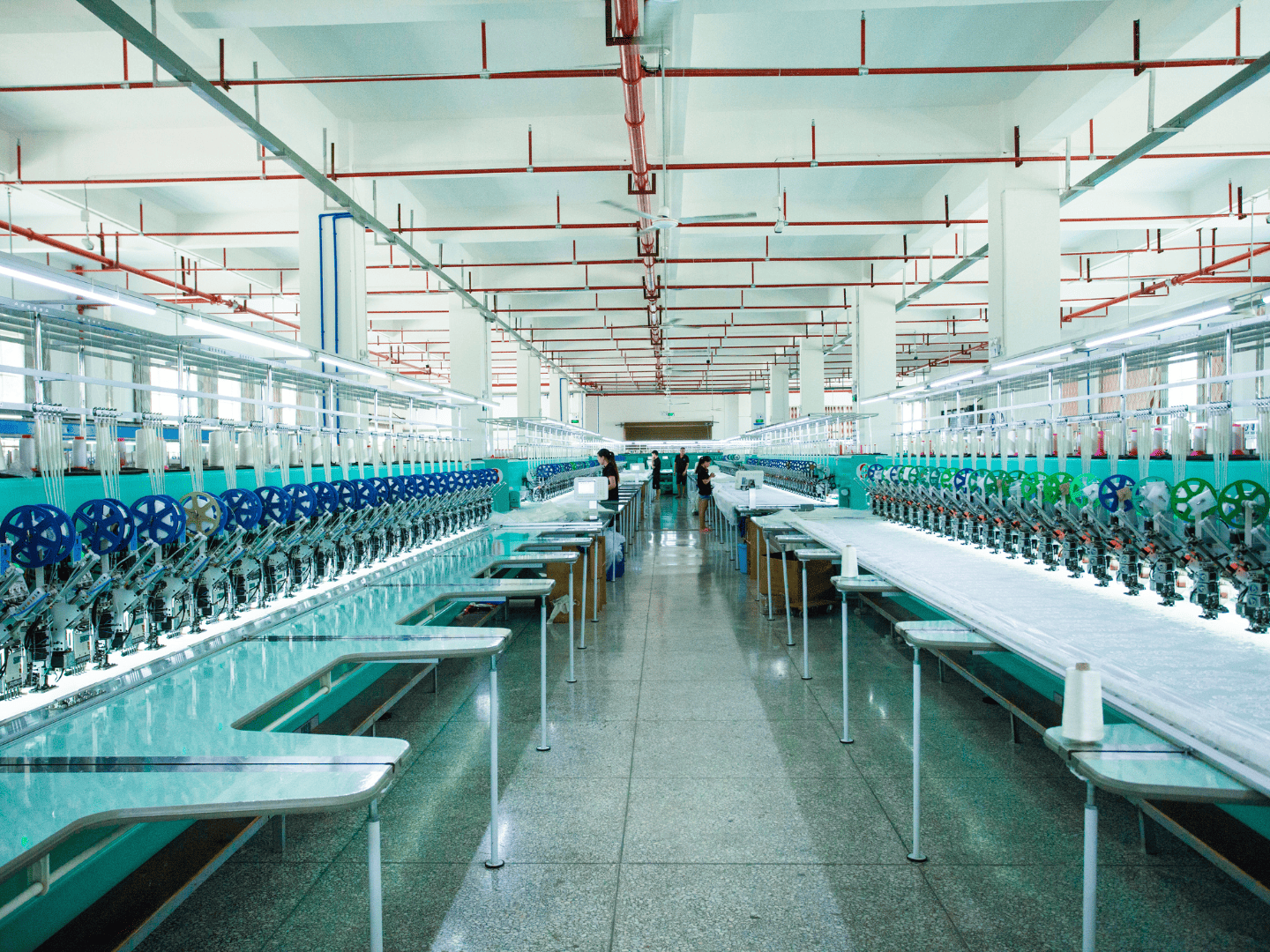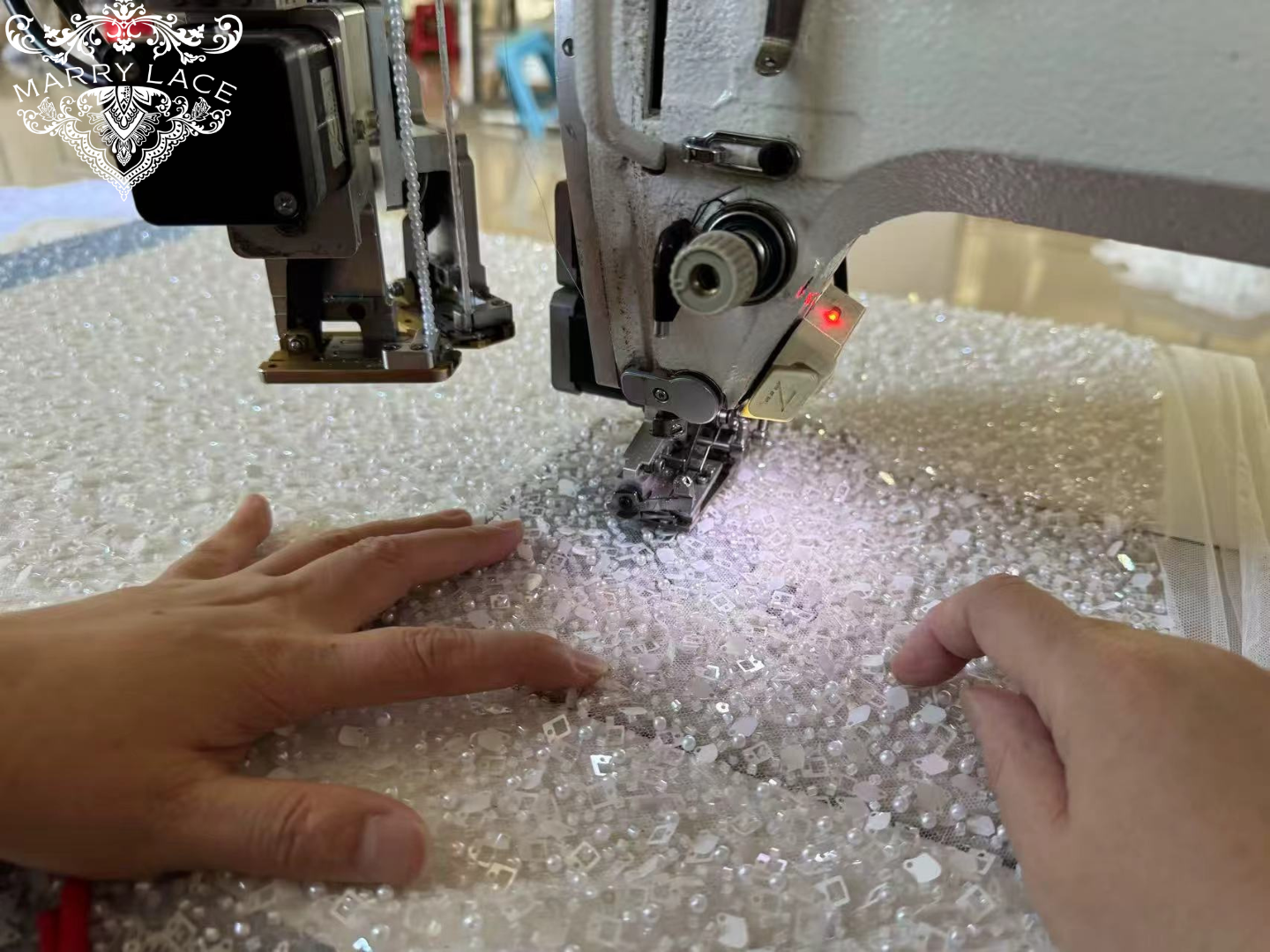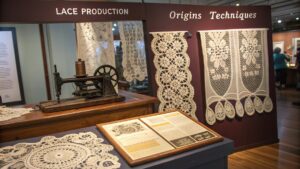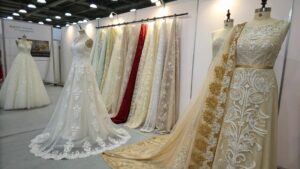Traditional handmade lace takes months to create. Modern factories need efficient methods to meet growing global demand for quality lace fabrics.
Factory lace production combines computer-controlled embroidery machines, precise material preparation, and systematic quality control processes. Modern facilities can produce complex embroidered lace patterns through automated digitization, multi-head embroidery systems, and specialized finishing techniques.
I’ve visited numerous lace manufacturing facilities throughout my career. The transformation from traditional handcraft to modern industrial production amazes me every time I see these sophisticated operations in action.
What Are the Key Steps in Factory Lace Production?
Modern lace manufacturing follows systematic processes that ensure consistent quality across large production volumes. Each step requires precise control and specialized equipment.
Factory lace production involves design digitization, material preparation, computer embroidery, hollow-out processing, quality inspection, and packaging. Professional manufacturers maintain strict controls at each stage to deliver consistent results.
Design and pattern creation form the foundation of quality lace production. Our designers at MarryLace first create detailed patterns based on client requirements or market trends. These designs specify flower motifs, color combinations, and technical details that guide the entire production process.
The digitization process1 converts artistic designs into machine-readable code. Specialized software translates pattern details into precise stitch coordinates, needle movements, and color changes. This digital file controls every aspect of the embroidery process, ensuring perfect pattern reproduction across thousands of yards.
Material selection and preparation require careful attention to base fabric characteristics. We use various foundation materials including nylon mesh, cotton net, and specialized substrates depending on the final lace application. Base materials undergo pre-treatment to ensure proper tension and flatness for consistent embroidery results.
Computer embroidery represents the heart of modern lace production. Our manufacturing facilities operate 30+ specialized embroidery machines in Hunan and 9 machines in Turkey, each capable of handling multiple needles and thread colors simultaneously. These machines execute complex stitch patterns with microscopic precision.
| Production Stage | Key Equipment | Quality Controls | Typical Duration |
|---|---|---|---|
| Design Creation | CAD software | Pattern approval | 2-5 days |
| Digitization | Specialized software | Code verification | 1-2 days |
| Material Prep | Tensioning frames | Substrate inspection | 4-8 hours |
| Embroidery | Multi-head machines | Real-time monitoring | 6-24 hours |
Hollow-out processing creates the characteristic openwork appearance of finished lace. After embroidery completion, we remove unbacked portions of the base material through various methods. Water-soluble substrates dissolve in high-temperature water baths, while other materials require mechanical trimming or laser cutting for precise hollow areas.
Quality inspection occurs throughout production rather than only at completion. Our technicians monitor thread tension, stitch consistency, and pattern registration during embroidery. This continuous oversight prevents defects from propagating through entire production runs.
How Do Modern Embroidery Machines Create Complex Lace Patterns?
Computer-controlled embroidery systems represent remarkable engineering achievements that make modern lace production possible. These machines combine mechanical precision with software intelligence.
Multi-head embroidery machines use servo motors, tension controls, and thread management systems to create intricate patterns. Advanced machines coordinate up to 24 needles simultaneously while maintaining perfect stitch consistency across wide fabric widths.
Thread management systems control multiple colors and weights simultaneously. Modern machines can switch between different thread types mid-pattern, creating beaded lace collection2 effects by incorporating metallic threads, sequins, or specialty fibers at precise locations.
I’ve watched these machines operate for hours, amazed by their precision. Each needle moves independently according to digital instructions, creating different stitch types including lock stitches, chain stitches, and specialty decorative stitches. The coordination between multiple needles produces complex layered effects impossible with traditional methods.
Tension control systems ensure consistent stitch quality across varying thread types and fabric tensions. Servo-controlled tensioners adjust automatically for different materials, preventing thread breaks while maintaining proper stitch formation. This automation eliminates the inconsistencies common in manual production methods.
Pattern registration systems ensure perfect alignment across fabric repeats. Laser guidance systems and mechanical positioning controls maintain precise spacing between pattern elements. This accuracy becomes critical for luxury bridal collection3 fabrics where pattern misalignment creates obvious quality issues.
| Machine Component | Function | Quality Impact | Maintenance Requirements |
|---|---|---|---|
| Servo motors | Needle positioning | Stitch precision | Daily calibration |
| Tension controls | Thread management | Stitch consistency | Weekly adjustment |
| Guidance systems | Pattern alignment | Repeat accuracy | Monthly verification |
| Thread feeders | Material supply | Production continuity | Continuous monitoring |
Speed control capabilities allow operators to adjust production rates based on pattern complexity. Simple patterns can run at maximum speeds, while intricate 3D floral embellishment 4 designs require slower speeds for proper thread placement and dimensional effects.
Real-time monitoring systems alert operators to potential problems before they affect product quality. Thread break sensors, tension monitors, and pattern verification systems provide immediate feedback about production status. This monitoring prevents costly material waste and ensures consistent output quality.
What Quality Control Measures Ensure Consistent Factory Lace Production?
Quality control systems distinguish professional manufacturers from amateur operations. Systematic quality measures prevent defects while maintaining production efficiency.
Comprehensive quality control includes raw material inspection, in-process monitoring, dimensional verification, and final product testing. Professional manufacturers implement multi-stage inspection protocols that catch defects early in the production process.
Raw material inspection begins before production starts. We test all incoming threads for tensile strength, color consistency, and dimensional stability. Base fabrics undergo shrinkage testing, tear strength verification, and surface quality inspection. These preliminary checks prevent quality issues from propagating through finished products.
In-process monitoring occurs continuously during embroidery operations. Our quality technicians check stitch density, pattern registration, and thread placement at regular intervals. MarryLace’s design process includes specific checkpoints that ensure patterns develop correctly throughout production runs.
Color consistency verification5 becomes critical when producing large quantities of wholesale lace fabric6. We maintain strict dye lot controls and use spectrophotometer measurements to verify color matching across production batches. This attention to color accuracy prevents costly rejections from quality-conscious clients.
Dimensional stability testing7 ensures finished lace maintains proper measurements after processing. We subject samples to washing tests, heat exposure, and humidity cycles that simulate real-world conditions. This testing prevents shrinkage surprises that could affect garment construction.
| Quality Parameter | Testing Method | Acceptance Criteria | Testing Frequency |
|---|---|---|---|
| Thread strength | Tensile testing | >95% of specification | Every batch |
| Color matching | Spectrophotometer | <1.0 Delta E variation | Continuous |
| Stitch density | Microscopic count | ±5% of target | Hourly sampling |
| Pattern accuracy | Digital measurement | <0.5mm deviation | Every 100 yards |
Final inspection protocols verify that finished lace meets all specifications before packaging. Trained inspectors examine each production run for pattern completeness, edge finishing quality, and overall appearance. We maintain detailed inspection records that document quality trends and identify improvement opportunities.
Customer feedback integration helps refine quality standards continuously. We track client satisfaction metrics and incorporate feedback into our quality control procedures. This customer-focused approach ensures our standards align with market expectations and application requirements.
How Do Factories Handle Different Lace Types and Specializations?
Modern lace factories must accommodate diverse product requirements ranging from delicate bridal applications to heavy-duty industrial uses. Production flexibility determines manufacturing success.
Specialized production lines handle different lace categories through equipment configurations, material selections, and process modifications. Professional facilities maintain capabilities for embroidered lace, chemical lace, and mixed-media applications.
Embroidered border design production requires different equipment setups compared to all-over pattern manufacturing. Border designs use specialized needle configurations and fabric feeding systems that accommodate narrow width production while maintaining pattern precision.
Chemical lace production8 involves completely different processes compared to embroidered varieties. After completing embroidery on dissolvable substrates, we use controlled water baths or chemical treatments to remove backing materials. Modern facilities use environmentally responsible dissolution methods that minimize waste and chemical usage.
Rhinestone applications 9require specialized attachment equipment and quality control procedures. Heat-setting machines apply rhinestones at precise temperatures and pressures to ensure permanent attachment without damaging surrounding lace structures.
Mixed-media lace10 combines multiple techniques within single production runs. These complex products might incorporate embroidered elements, applied beads, and cut-work sections all in coordinated patterns. Such production requires careful scheduling and equipment coordination to maintain efficiency.
| Lace Type | Specialized Equipment | Unique Processes | Quality Considerations |
|---|---|---|---|
| Embroidered | Multi-head machines | Digital pattern control | Stitch consistency |
| Chemical | Dissolution tanks | Substrate removal | Complete backing removal |
| Beaded | Application machines | Heat/pressure setting | Attachment security |
| Mixed-media | Multiple systems | Process coordination | Element integration |
Production scheduling becomes complex when handling multiple lace types simultaneously. We maintain dedicated production lines for different categories while sharing support services like design, quality control, and shipping. This organization maximizes efficiency while maintaining specialization capabilities.
Custom color development11 requires flexible dyeing and color matching capabilities. Our facilities maintain extensive color libraries and can match virtually any specified color within tight tolerances. This capability supports designers who need specific color coordination for their collections.
Conclusion
Modern factory lace production combines advanced technology with traditional craftsmanship principles, creating efficient systems that deliver consistent quality across diverse product categories and applications worldwide.
-
Understanding the digitization process is crucial for grasping how artistic designs are transformed into machine-readable formats, ensuring quality in lace production. ↩
-
Explore how beaded lace collection enhances fashion designs with unique textures and styles. ↩
-
Discover the elements that make luxury bridal collections stand out in the wedding industry. ↩
-
Learn about the innovative techniques behind 3D floral embellishments and their impact on fashion. ↩
-
Discover the significance of color consistency verification and how it impacts product quality and client satisfaction. ↩
-
Explore this link to understand the essential practices for ensuring quality in wholesale lace fabric production. ↩
-
Learn about the methods and importance of dimensional stability testing to prevent issues in garment construction. ↩
-
Explore this link to understand the unique processes and environmentally responsible methods used in chemical lace production. ↩
-
Discover the specialized equipment and quality control procedures essential for successful rhinestone applications. ↩
-
Learn about the innovative techniques that combine various elements in mixed-media lace for unique designs. ↩
-
Find out how flexible dyeing and color matching capabilities can enhance your lace designs with precise color coordination. ↩








